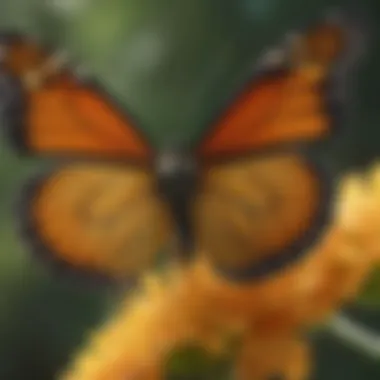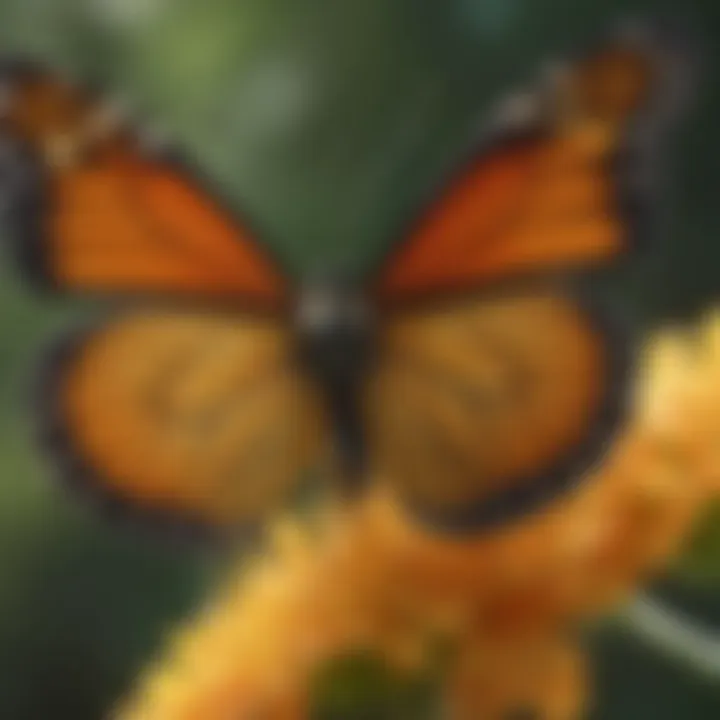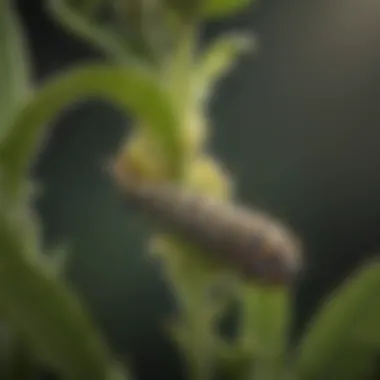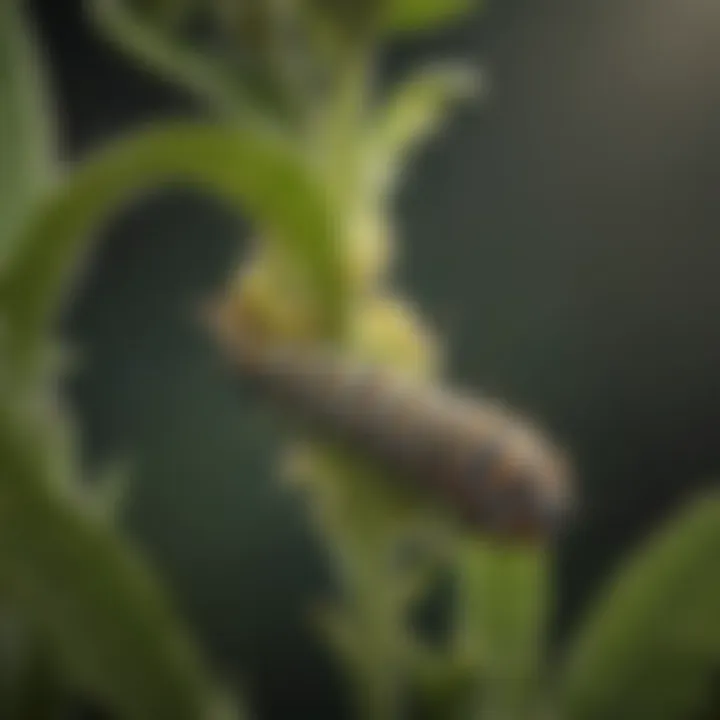Exploring Monarchs: Biology, Ecology, and Culture


Intro
The intricate relationship between monarchs and woodland ecosystems shapes both the biodiversity and ecological balance of forests. Monarchs, particularly the Monarch butterfly, are emblematic of environmental health. Their migration patterns, life cycles, and interactions within these ecosystems provide critical insights into broader environmental issues. By exploring these topics, we can appreciate how monarchs are not just beautiful creatures but vital components of forest ecosystems. This article aims to unravel these connections while discussing sustainable practices that can help protect and enhance these vital habitats.
Understanding Woodland Ecosystems
Woodland ecosystems are complex networks that support a variety of life forms. Monarchs play a role in these ecosystems that extends beyond their visual aesthetics. These butterflies are pollinators, which means they assist in the reproduction of many plant species. The exchange of energy and nutrients among different organisms creates a dynamic balance.
Importance of Biodiversity in Forests
Biodiversity within forests is essential for resilience. Higher biodiversity often leads to better resource availability, improved nutrition, and enhanced resistance to disease. Monarchs, among other species, help maintain this diversity. Their presence indicates a healthy ecosystem, one where trees, plants, and insects can thrive in harmony.
- Monarchs contribute to:
- Pollination services
- Food chain stability
- Soil health improvement
Role of Forests in Climate Regulation
Forests act as carbon sinks, absorbing carbon dioxide and helping mitigate climate change. Monarchs migrate across various habitats, demonstrating how climate affects their patterns. Their lifecycle is deeply tied to environmental conditions, such as temperature and precipitation patterns, showcasing the delicate balance of these ecosystems.
"The health of monarch populations can serve as an indicator of the overall health of the environment."
Sustainable Forestry Practices
Adopting sustainable forestry practices is key to preserving the habitats of monarchs and ensuring the longevity of woodland ecosystems.
Principles of Sustainable Forestry
Sustainable forestry incorporates methods that balance ecological health with economic viability. Key principles include:
- Protecting biodiversity
- Maintaining forest ecosystems
- Minimizing environmental impact
These principles aim to create a forest management approach that conserves resources for future generations while allowing for responsible usage today.
Case Studies of Successful Implementations
Examining successful sustainable forestry implementations can provide valuable insights for future practices. For instance, the use of selective logging in regions like the Pacific Northwest has been shown to enhance biodiversity. Similarly, initiatives that incorporate native plant restoration help maintain the ecosystems where monarchs thrive.
Woodland Stewardship Techniques
Effective woodland stewardship is crucial to maintaining healthy ecosystems where monarchs can prosper.
Forest Management Plans
A detailed forest management plan should be established. These plans need to account for the health of flora and fauna and incorporate practices designed to protect wildlife habitats.
Conservation Strategies
Implementing conservation strategies is vital. Strategies might involve:
- Establishing protected areas
- Promoting community engagement in conservation efforts
- Supporting educational programs about forest health
Understanding Monarchs
Understanding monarchs is crucial for grasping their role in both ecosystems and human culture. Monarch butterflies are more than just beautiful insects; they serve as indicators of environmental health. Their ability to thrive in clean, biodiverse habitats underscores the importance of preserving such environments. In the context of this article, it is essential to explore the biological and ecological facets of monarchs.
Key elements include their life cycle, ecological roles, and cultural impacts. Recognizing these aspects can enhance our appreciation of their importance in the ecosystem and inform future conservation efforts. Monarchs also represent a unifying symbol across various cultures, making understanding their significance even more vital.
Defining Monarchs
Monarchs, specifically referring to the monarch butterfly, Danaus plexippus, are renowned for their striking orange and black coloration and impressive migratory patterns. These insects are part of the Nymphalidae family within the Lepidoptera order. The definition of a monarch encompasses both the biological characteristics that define them and the ecological roles they fulfill in various habitats.
Biological Classification
Biological classification allows us to make sense of the diversity within the species and its relatives, providing a higher level of understanding.


Taxonomy Overview
Taxonomy is the science of classification and represents a systematic approach to organizing living organisms. This article highlights the significance of taxonomy in understanding monarchs as it classifies them into a broader ecological context. The taxonomy of the monarch emphasizes its relationships with other species within the Nymphalidae family. A crucial characteristic is its specific lineage, highlighting its unique evolution. The insightful classification can benefit conservation efforts by identifying related species that may share habitats and threats, thus closing knowledge gaps on broader ecological interactions.
Species Variations
There are various species variations within the monarch group, including regional subspecies which have adapted to specific environments. Understanding these variations is important for studying monarch biology. The diversity within species helps to illustrate the concept of adaptation and evolution in action. Knowledge of these species is beneficial to discussions within this article, particularly in relating conservation strategies to the specific needs of each variation. Different appearances and behaviors can also be observed, which can influence their chances of survival and reproduction.
Physical Characteristics
Physical characteristics play a significant role in how monarchs navigate their environment. Monarchs are distinguished by their bright coloration, primarily orange with black edges. This coloration serves as a warning to potential predators about their toxicity, a trait developed from their diet as caterpillars feeding on milkweed. Understanding these traits is beneficial in assessing the ecological dynamics of the species. Furthermore, distinguishing features may have advantages in camouflage and mimicry, influencing predator-prey relationships.
"The amazing beauty of monarchs serves as a reminder of the interconnection between ecology and culture, making them indispensable to environmental health and human experience."
Overall, understanding monarchs through biological classification provides a comprehensive framework for detailed exploration throughout this article, laying the groundwork for further discussions on their lifecycle, contributions to ecosystems, and cultural significance.
The Monarch Lifecycle
Understanding the Monarch Lifecycle is essential as it captures the complex journey of monarchs through distinct phases: egg, caterpillar, pupa, and adult. Each stage plays a critical role in their development and endurance. The lifecycle not only illustrates the biological processes of these insects but also highlights their resilience and adaptability in changing environments. It establishes a foundation for further discussions on ecological impact and conservation efforts. By recognizing these phases, we can better appreciate the interconnectedness of monarchs with their ecosystems and the importance of their conservation.
Egg Stage
The Egg Stage represents the beginning of the monarch's life cycle. Monarchs lay eggs on milkweed plants, which are crucial for the larval stage. Female monarchs are particular about the selection of host plants, ensuring high survival rates of their offspring. In this stage, which lasts approximately three to ten days, the eggs undergo a transformation that contributes significantly to the overall development of the species. The egg's positioning on the underside of leaves protects them from predators and environmental factors.
Caterpillar Stage
Feeding Habits
During the Caterpillar Stage, also known as the larval stage, monarchs primarily consume milkweed leaves. This feeding habit has profound implications. The plants contain toxins called cardenolides, which monarchs absorb. These toxins make the caterpillars unpalatable to potential predators. This stage, lasting about ten days, showcases a key characteristic: the caterpillar's ability to gain significant mass and size rapidly. The caterpillar's choice of diet is advantageous as it prepares it for the demands of metamorphosis, enabling the larva to store energy for the transition to pupa. Nonetheless, this diet also limits their habitat, confining them primarily to areas where milkweed is accessible.
Growth Phases
The Growth Phases of the caterpillar involve multiple molts, usually occurring five times before they pupate. Each phase sees the monarch shedding its skin to accommodate its increased size. This characteristic growth pattern is instrumental in developing a robust adult capable of surviving in its environmental niche. While growth is crucial, it can also become detrimental, particularly if external conditions, such as predation or habitat loss, intervene. Understanding the caterpillar's growth trajectory is vital for conservation strategies aimed at protecting these organisms in their early life stages.
Pupal Stage
Chrysalis Formation
The Chrysalis Formation is a mesmerizing phase where the caterpillar undergoes a profound transformation. The caterpillar secures itself to a safe surface and envelops itself in a chrysalis. This process typically takes about ten days. The chrysalis provides a protective barrier while the caterpillar morphs into a butterfly. This critical step signifies not just a physical transformation but also the potential for future reproductive success. However, the vulnerability of this stage is high, as environmental factors can jeopardize the developing butterfly, affecting the population.
Metamorphosis Process
The Metamorphosis Process is a remarkable transformation that takes place within the chrysalis. The caterpillar's body breaks down to form new structures, leading to the emergence of the adult butterfly. This entire procedure offers insights into adaptation and ecological fitness, showcasing how monarchs evolve to thrive in diverse environments. The metamorphosis, lasting up to two weeks, presents a pivotal moment, as successful transitions ultimately affect population viability. However, the sensitive nature of this phase poses risks that can lead to fewer adults if environmental conditions are unfavorable.
Adult Monarchs
Mating Behaviors
Adult monarchs exhibit distinct Mating Behaviors that occur during specific seasons. Males usually engage in a variety of courtship displays, including aerial dances, to attract females. Successful mating is essential for the continuation of the species. This phase usually occurs post-migration, ensuring that eggs laid are in environments with adequate resources. Understanding these behaviors can provide critical insights into the reproductive success and genetic variability of populations, which is beneficial for targeted conservation efforts.
Migration Patterns
The Migration Patterns of adult monarchs are fascinating and complex. Monarchs are known for their long-distance migrations, traveling thousands of miles from North America to central Mexico. This behavior is significant as it enables them to escape winter conditions and find mating grounds. They rely on environmental cues, such as temperature and daylight length. The ability to navigate such distances is key to species survival; however, changing climates and habitat loss pose threats to their migratory routes. Recognizing these patterns is critical for understanding the health of the species and ecosystems they inhabit.
Ecological Role of Monarchs
Monarchs play a crucial role in their ecosystems, acting as both pollinators and integral players in food web dynamics. Understanding this ecological role is essential for grasping the significance of monarchs within their habitats. Their activities influence not just their populations but also the health of various plant species and the stability of broader biological communities. Consequently, the conservation of monarchs is not solely about preserving a single species but ensuring the integrity of the ecosystems they inhabit.
Pollination
Monarchs are vital pollinators for a range of flowering plants. Their interaction with flora helps ensure reproduction in many species which in turn supports food webs. This mutualistic relationship benefits monarchs and plants alike, fostering biodiversity.
Pollination through monarchs enhances genetic variation within plant populations. This variation is essential for adaptations to environmental changes. Additionally, many plants that depend on monarchs for pollination contribute to the structure of ecosystems by providing habitat and food for other species.
Food Web Dynamics


The interrelationships between species in an ecosystem often hinge on connections like those formed through food webs. Monarchs occupy a unique position in this framework. They serve as both prey and predators, illustrating the intricate balance of these systems.
Predators and Prey Relationships
In the context of predators and prey relationships, monarchs are predominantly prey for various birds and other insects. Their presence indicates aspects of ecosystem health. A decline in monarch populations may suggest broader issues within the ecosystem, such as habitat loss or pesticide use.
The consumption of monarchs by predators also benefits these predators by providing necessary nutrients. This dynamic ensures that energy moves through the food web effectively. Nevertheless, predators that rely too heavily on monarchs can also negatively impact their populations, suggesting a need for balance.
Impact on Biodiversity
The impact of monarchs on biodiversity is profound. As they contribute to pollination, they support plant diversity, which in turn sustains a variety of other wildlife. Monarchs help maintain diverse habitats, which enhance ecosystem resilience against climate change and other stressors.
Their role as both pollinator and prey enriches interactions within food webs. A decline in monarchs can lead to reduced plant diversity and, subsequently, influence the species that thrive in these habitats. This cascading effect showcases the importance of conserving monarchs not just for their existence but for the overall health of the ecosystems they inhabit.
"When we think of biodiversity, we must consider the role of specific species like monarchs, who are keystones in maintaining ecological balance."
The multifaceted roles of monarchs demonstrate their importance in sustaining ecological integrity. By protecting these butterflies, we invest in the futures of ecosystems vital for many forms of life.
Monarchs and Climate Change
The impacts of climate change on monarchs are multifaceted and deserve careful examination. As indicators of ecosystem health, monarchs reflect the broader effects of environmental shifts. Understanding how climate change influences their behaviors and habitats is crucial for conservation efforts. This section identifies specific factors, including temperature fluctuations and migration alterations, that directly affect monarch populations.
Effects of Temperature Changes
Temperature shifts can significantly influence the lifecycle and survival of monarchs. With rising global temperatures, the breeding season may begin earlier, disrupting the synchronization with the availability of essential milkweed plants, which serve as the primary food source for caterpillars. If the caterpillars do not find enough milkweed at the right time, their development may be stunted.
Furthermore, increasing temperatures can lead to an increase in the rate of mortality during the pupal stage. Monarchs are sensitive to extreme temperature conditions. Both unseasonably high and low temperatures can disrupt the metamorphosis process in the chrysalis phase. As a result, even minor temperature variations could lead to lower survival rates.
- Consequences of temperature changes:
- Early breeding cycles
- Impaired caterpillar growth
- Reduced survival during pupation
Alterations in Migration Patterns
Migration patterns are a hallmark of the monarch species, particularly those in North America. Climate change presents potential disruptions to these well-established routes. As temperatures warm, traditional overwintering sites in Mexico may become less favorable. This can force monarchs to alter their migration paths, leading to potential increases in mortality if they cannot find suitable habitats along the way.
Moreover, changing climate affects the timing of migration. If environmental cues such as temperature and daylight are altered, monarchs may not migrate at optimal times, leading to mismatches with available resources.
"Monarch migration is not just a remarkable journey; it is a crucial survival strategy impacted by climate trends."
- Key factors influencing migration:
- Changes in overwintering habitats
- Timing conflicts due to environmental shifts
In summary, understanding how climate change affects monarchs provides valuable insights for their conservation. Both temperature changes and alterations in migration patterns highlight the urgent need for concerted efforts to protect these iconic creatures and their habitats.
Cultural Significance of Monarchs
Understanding the cultural significance of monarchs enriches the overall narrative of their role in ecosystems and human societies. Monarchs are not just insects; they are symbols of beauty, transformation, and resilience. Their migratory patterns captivate the imagination, representing endurance in the face of environmental change. This section will explore how monarchs connect to human cultures through mythology, art, and literature. These interactions impact both conservation efforts and public perception, emphasizing the need for a deeper appreciation of these butterflies.
Monarchs in Mythology
Monarchs often appear in various mythologies as symbols of change and metamorphosis. For example, in some Indigenous cultures, the butterfly is seen as a messenger between realms. In these narratives, monarchs embody the soul's journey, reflecting transformation and spiritual renewal. This significance can enhance awareness of monarchs as they are woven into the human experience.
These stories contribute to environmental awareness, motivating people to engage in conservation efforts. When cultures embrace the mythological aspects of monarchs, they foster respect and admiration for nature.
Representation in Art and Literature
Symbolism
In art and literature, the symbolism of monarchs is pronounced. The butterfly represents beauty and transience. It also serves as a powerful metaphor for personal change, self-discovery, and the complexity of life. Artists and writers draw on this symbolism to convey deeper meanings in their works. This aspect makes it a popular choice in various cultural narratives.
The unique feature of monarch symbolism lies in its multi-faceted nature. It can embody themes of hope, fragility, and resilience. These characteristics become beneficial when discussed in the context of environmental health and conservation. The awareness of these themes can cultivate a protective mindset towards nature, enhancing conservation strategies while resonating strongly with audiences.


Cultural Narratives
Cultural narratives surrounding monarchs focus on their journey and transformation. Stories that highlight their migration not only entertain but also educate the public about the importance of ecological balance. These narratives often depict struggles and triumphs, reflecting larger themes in human experiences.
The key characteristic of these cultural narratives is their ability to engage the audience on an emotional level. This engagement makes them effective tools for conservation messages, as they appeal to empathy and urgency. However, the oversimplification of these narratives can lead to loss of nuance. Therefore, it is crucial to tell these stories in a way that maintains depth, ensuring that audiences grasp the broader ecological implications of monarchs' existence and behavior.
"Monarchs serve as a reminder of nature's fragility and the need for stewardship."
Conservation Efforts
The conservation of monarchs is an urgent topic, given the current threats they face. These creatures play not only a role in biodiversity but also contribute significantly to ecological health. Their populations have been in decline due to habitat loss, pesticide use, and climate change. Understanding conservation efforts is vital for both the survival of monarchs and the overall integrity of ecosystems they inhabit.
Global Conservation Initiatives
Efforts aimed at conserving monarchs are becoming more prominent. Various organizations are implementing global initiatives to protect these butterflies and their habitats. Some of the notable programs include:
- Monarch Joint Venture: A collaborative effort involving numerous partners focused on habitat management and research.
- Monarch Watch: A citizen science program that educates the public on monarch habitats and encourages community action.
- International Monarch Conservation Plan: An extensive approach that focuses on cross-border collaboration, especially between the United States and Mexico.
These initiatives illustrate a growing recognition of the need for coordinated efforts across regions to ensure that the migratory corridors essential for monarchs are preserved for future generations.
Community Involvement
Local communities are integral to the success of conservation efforts. Grassroots movements are often the most effective way to raise awareness and mobilize action. Individual contributions through local stewardships can be remarkably beneficial.
Local Stewardship Programs
Local stewardship programs empower communities to take charge of their local environments. These programs often include:
- Habitat restoration activities.
- Educational workshops about the importance of monarchs and their habitats.
- Involvement in monitoring local butterfly populations.
The key characteristic of local stewardship programs is community involvement. They foster a sense of ownership and responsibility. One unique feature of these programs is their adaptability. Each program can be tailored to fit specific local needs and conditions. This can result in a high degree of effectiveness. However, challenges include securing consistent funding and engaging the wider community.
Awareness Campaigns
Awareness campaigns serve a crucial purpose in educating the public about the plight of monarchs. These campaigns often involve collaboration between schools, environmental organizations, and media outlets. They aim to raise awareness about:
- The importance of milkweed and native plants.
- The impact of pesticides on butterfly populations.
- The significance of conservation efforts in local ecosystems.
The hallmark feature of awareness campaigns is their emphasis on outreach and education. They can be effectively implemented through social media platforms and community events. While they can successfully draw attention, measuring the direct impact of these campaigns can often be difficult. Nonetheless, they remain a popular and effective choice for encouraging public participation in conservation efforts.
"The survival of monarchs depends on not only scientific measures but also the collective efforts of communities worldwide."
In summary, conservation of monarchs requires a multifaceted approach that includes global initiatives and vibrant community involvement. The success of these efforts is intertwined with public knowledge and engagement.
Future Directions in Monarch Research
Research into monarch butterflies has consistently expanded in scope and depth. The future directions in this field are crucial for understanding their biology and how to protect them effectively. New methodologies promise to enhance conservation efforts and provide fresh insights into the complexities of monarch ecology.
Emerging Technologies in Conservation
The integration of emerging technologies in conservation is gaining prominence. These technologies include satellite tracking, DNA analysis, and remote sensing. They allow researchers to gather vast amounts of data efficiently and analyze it in real-time. This can lead to informed decision-making and improved conservation strategies.
- Satellite Tracking: This method offers vital information on migration routes and habitat selection. It enables scientists to monitor real-time movements of monarch populations, assessing their responses to environmental changes.
- DNA Analysis: Genetic studies contribute to understanding species variations. They help in identifying distinct populations and their specific needs, which is vital for localized conservation efforts.
- Remote Sensing: This technique provides large-scale ecological data that can assist in habitat mapping and monitoring. It allows the identification of changes in land use impacting monarch habitats.
Transdisciplinary Approaches
Adopting transdisciplinary approaches enriches the research landscape. This method links ecology, climate science, and social sciences. By collaborating across disciplines, scientists can tackle conservation issues holistically.
Integrating Climate Science and Ecology
Integrating climate science and ecology enhances our understanding of environmental dynamics. This approach focuses on how climate factors, such as temperature and precipitation patterns, affect monarch populations and their habitats. The synergy between these fields allows for a more robust analysis of threats posed to monarchs.
- Key Characteristics: A strong aspect is the prediction of migration patterns influenced by climate change. As temperatures rise, migration timings may shift, impacting breeding success.
- Unique Features: This integration fosters collaborative research. Scientists can share methodologies, improving data accuracy and broadening insights into ecological impacts. While beneficial, challenges include coordinating methodologies and differing terminologies across disciplines.
Societal Impacts on Conservation
Societal impacts on conservation refer to the influence of community actions on monarch preservation. This aspect considers how public awareness and participation can drive successful conservation efforts. It emphasizes community involvement as a critical factor in promoting sustainable practices.
- Key Characteristics: Public engagement leads to increased awareness of monarch issues. Educational initiatives can transform community perceptions, making conservation efforts more effective.
- Unique Features: Community stewardship programs can yield local solutions tailored to specific needs. However, the challenge lies in balancing diverse views and motivations within a community, which can complicate collaborative efforts.
The integration of various fields in monarch research is not just a trend but a necessity to adapt to global environmental changes.







